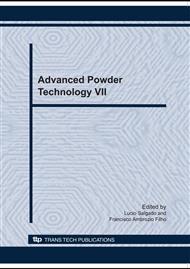p.893
p.899
p.904
p.910
p.916
p.922
p.928
p.936
p.943
Evaluation of Glycine Excess over NiAl2O4 Catalysts Prepared by Combustion Reaction for Steam Methane Reforming
Abstract:
The aim of this work is to evaluate the catalytic activity of NiAl2O4 powders, prepared by combustion reaction with different glycine contents, for the steam reforming of methane. The NiAl2O4 powders were prepared according to the theory of propellants and explosives, using glycine reductant in stoichiometric ratio (Φe = 1) and in excess of 10% and 20% (Φe < 1). During the synthesis, parameters such as flame combustion temperature and time were measured. The samples were characterized by XRD, textural analysis by nitrogen adsorption (BET/BJH), TPR and evaluated as catalysts for the steam reforming of methane. The XRD results showed the presence of NiAl2O4 as major phase and traces of NiO and Ni in all the samples. The glycine content increase caused a decrease of crystallite size and an increase of surface area, from 29 to 39 m2/g. The TPR profiles showed reduction peaks of NiO species in weak interaction with the support, and reduction of nickel present in the NiAl2O4. It was observed that higher methane conversions were obtained in the presence of NiAl2O4 samples prepared using glycine excess. However, it was also observed a rapid deactivation of these catalysts due to high coke deposition onto the active surface phases.
Info:
Periodical:
Pages:
916-921
Citation:
Online since:
October 2010
Keywords:
Price:
Сopyright:
© 2010 Trans Tech Publications Ltd. All Rights Reserved
Share:
Citation:


